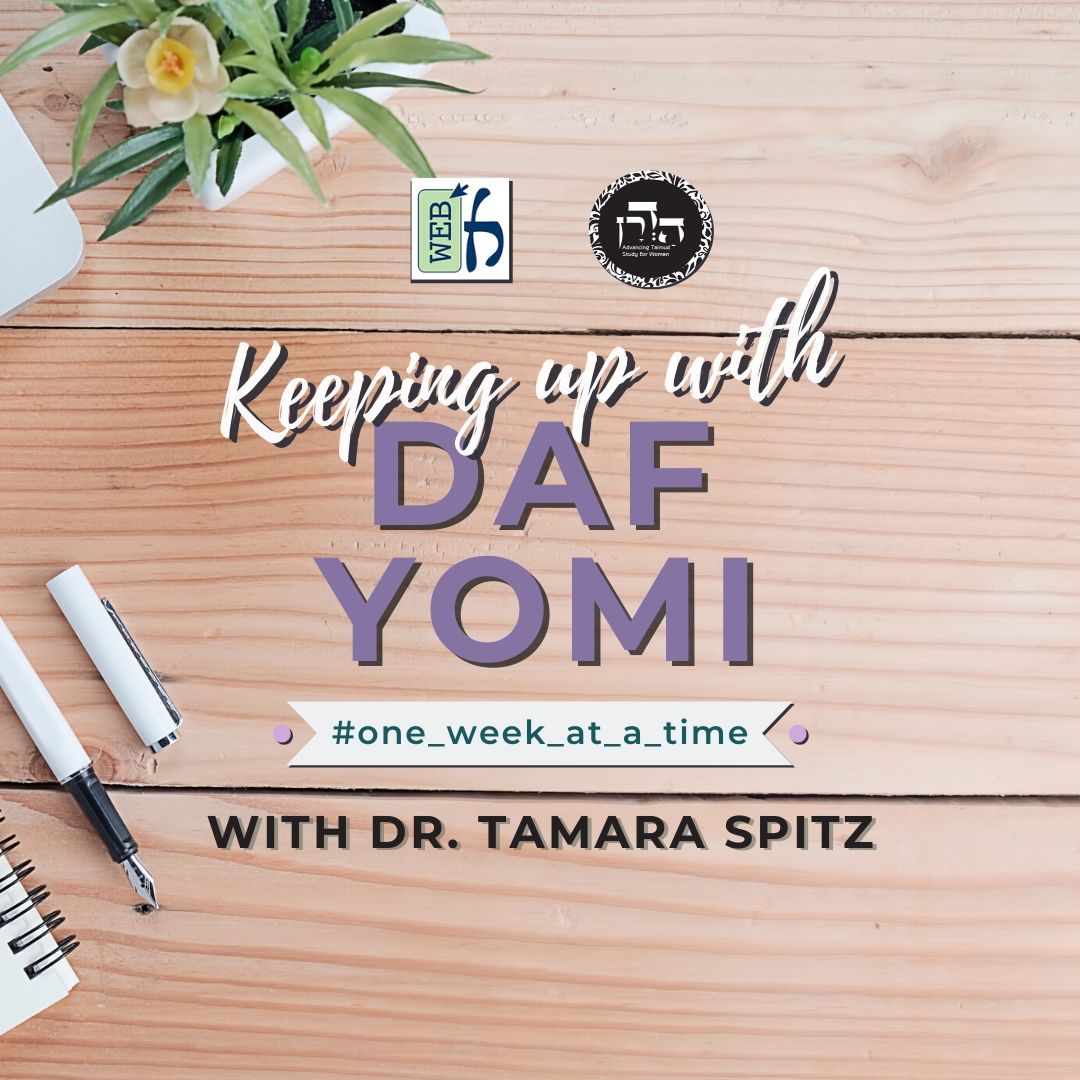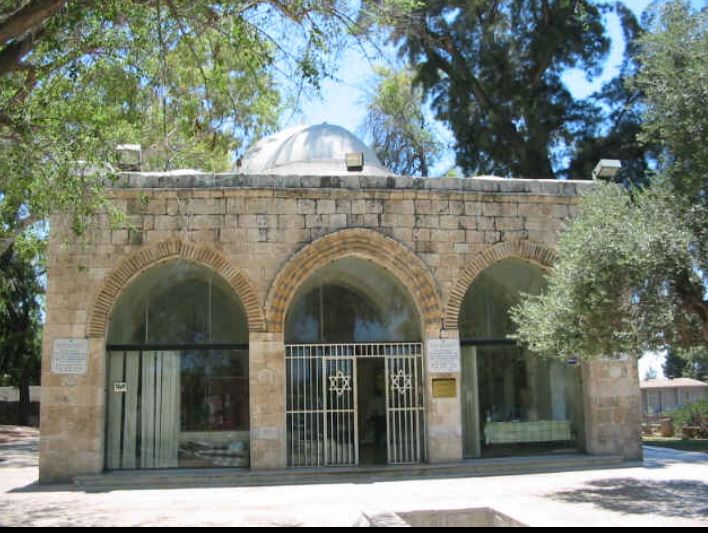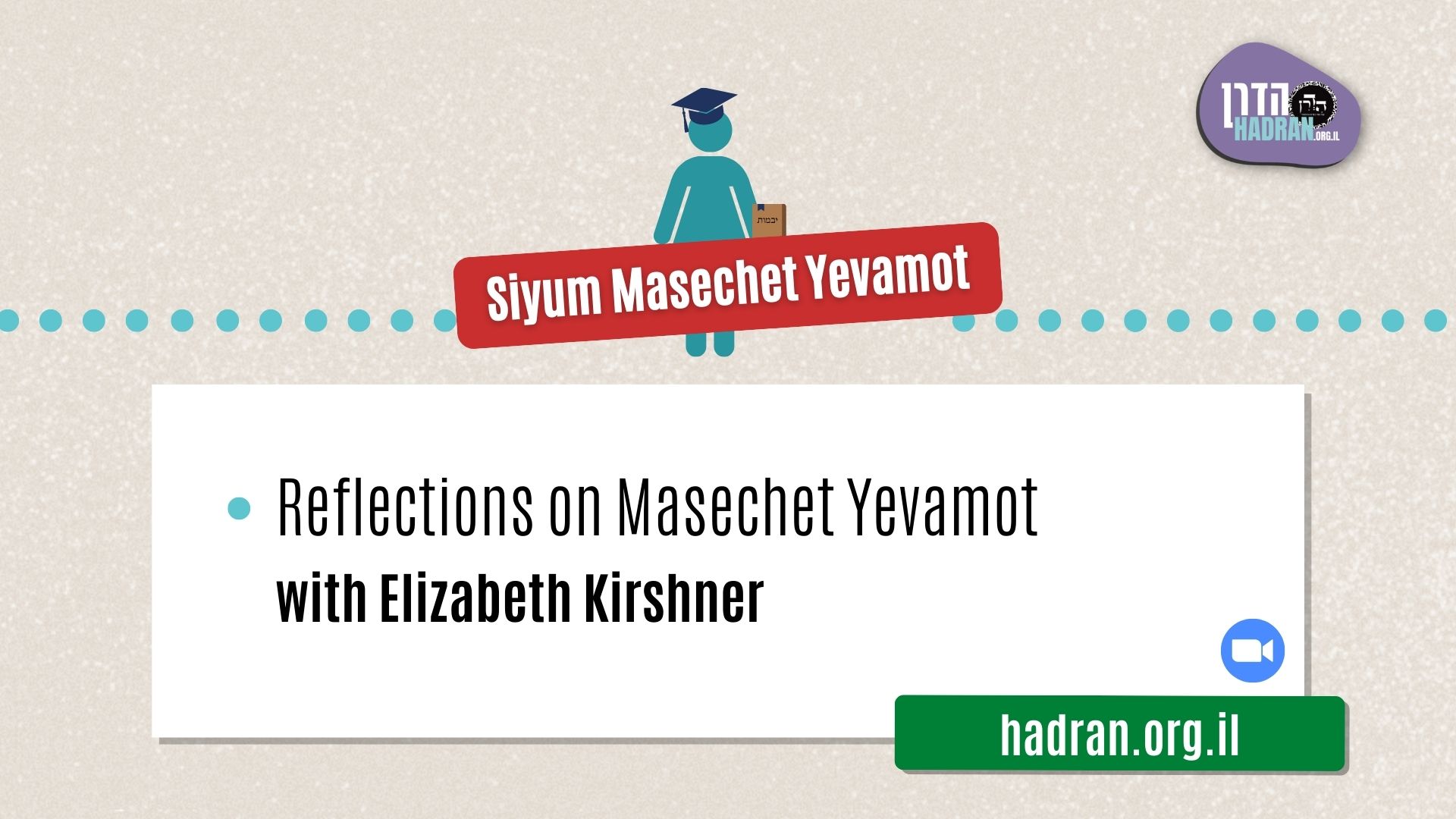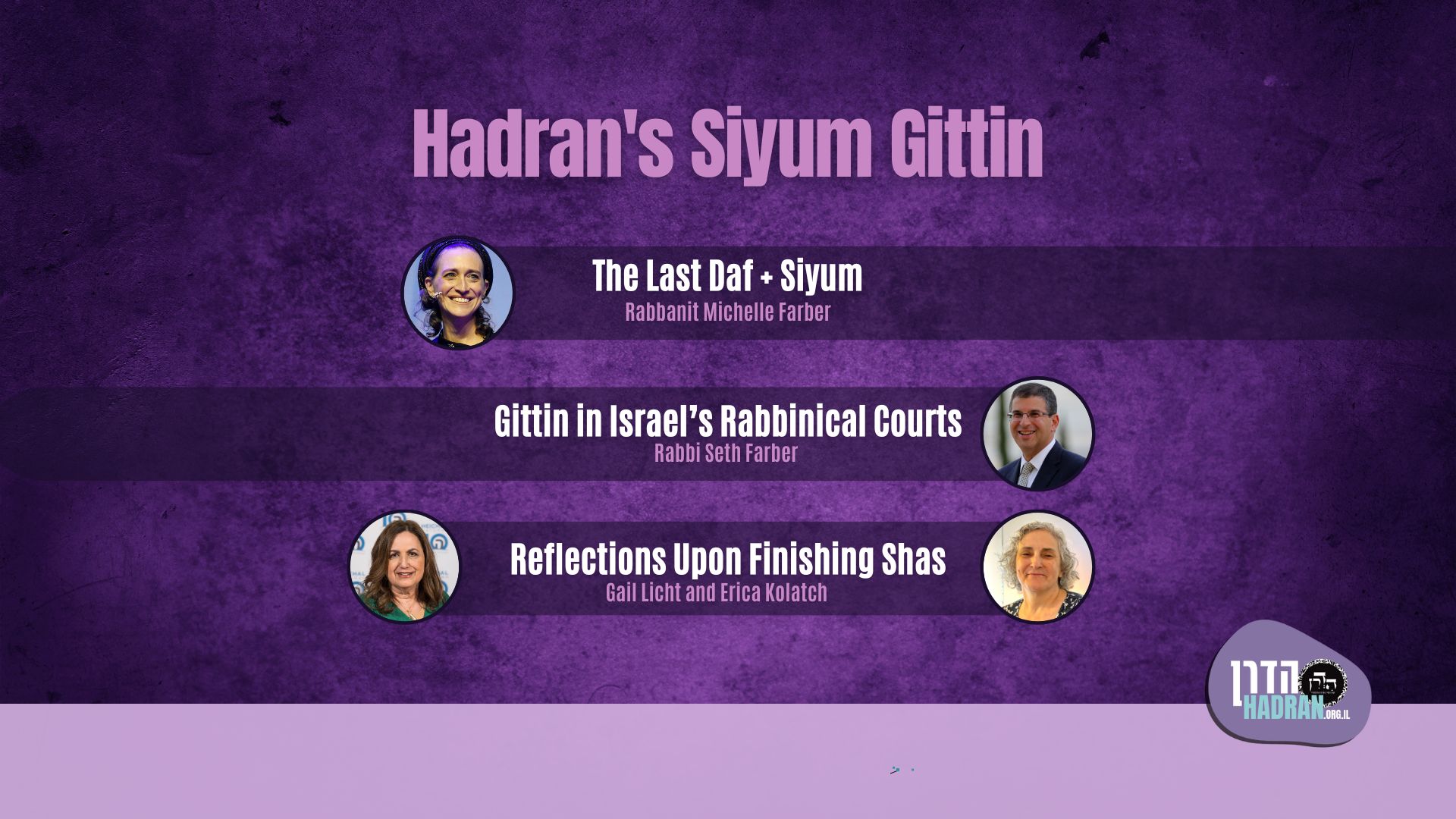Within what time frame does one need to slaughter the firstborn? On what does it depend? What if one determines there is a blemish but he/she was not an expert and on the basis of their determination, the owner slaughtered the animal – is the meat allowed to be eaten if an expert determines after death that there was a blemish? If not, does the one who originally determined it was blemished need to compensate the owner for the loss? If so, how much? If a judge makes a mistaken ruling, is the case reversed? If not, does the judge need to financially compensate for the loss?
This week’s learning is sponsored by Caroline Bollag l’ilui nishmat Pinchas ben Menashe Peyser.
Want to dedicate learning? Get started here:


Today’s daily daf tools:
This week’s learning is sponsored by Caroline Bollag l’ilui nishmat Pinchas ben Menashe Peyser.
Today’s daily daf tools:
Delve Deeper
Broaden your understanding of the topics on this daf with classes and podcasts from top women Talmud scholars.
New to Talmud?
Check out our resources designed to help you navigate a page of Talmud – and study at the pace, level and style that fits you.
The Hadran Women’s Tapestry
Meet the diverse women learning Gemara at Hadran and hear their stories.
Bekhorot 28
וְאִידַּךְ, אִי מֵהָתָם אִיכָּא לְמֵימַר חָזֶה וָשׁוֹק שֶׁל תּוֹדָה.
And the other ones, i.e., the Sages from the school of Rav, why don’t they derive the halakha that a firstborn is eaten for two days and one night from that verse? The Gemara answers that if it were derived from there, it would be possible to say that the verse is comparing the halakha of a firstborn to the breast and thigh of a thanks offering, which are eaten for only one day and night.
וְאִידַּךְ, אָמַר קְרָא: ״לְךָ יִהְיֶה״ — הוֹסִיף לְךָ הַכָּתוּב הֲוָיָה אַחֶרֶת בִּבְכוֹר.
The Gemara asks: And the other one, Rav Yehuda, citing Rav, how does he respond to this? The verse states: “And their flesh shall be yours, as the breast of waving and as the right thigh, it shall be yours” (Numbers 18:18). The verse adds another mention of a form of the term being in the second phrase: “It shall be yours,” to teach that the priest has an additional day to eat a firstborn animal, i.e., that it is compared to the breast and thigh of a peace offering, not to that of a thanks offering.
וְאִידַּךְ, הָא מֵהָתָם אִיכָּא לְמֵימַר: הַאי ״יִהְיֶה לָּךְ״ — לִימֵּד עַל בְּכוֹר בַּעַל מוּם שֶׁנּוֹתְנוֹ לְכֹהֵן, שֶׁלֹּא מָצִינוּ לוֹ בְּכׇל הַתּוֹרָה כּוּלָּהּ.
The Gemara asks: And the other ones, the Sages from the school of Rav, how do they respond to this claim? The Gemara answers: With regard to the inference from there, it is possible to say that this phrase: “It shall be yours,” teaches with regard to a blemished firstborn that the owner must give it to the priest. This derivation is necessary, as we have not found this halakha that a blemished firstborn is given to a priest stated explicitly anywhere in the entire Torah.
וְאִידַּךְ, אָמַר ״וּבְשָׂרָם״ — אֶחָד תָּם וְאֶחָד בַּעַל מוּם, וְאִידַּךְ — ״וּבְשָׂרָם״ דְּהָנֵי בְּכוֹרוֹת דְּכוּלְּהוּ יִשְׂרָאֵל קָאָמַר.
The Gemara asks: And the other one, Rav Yehuda, citing Rav, from where does he derive that a blemished firstborn is given to a priest? The verse states: “And their flesh shall be yours,” in the plural, i.e., both an unblemished firstborn and a blemished firstborn. The Gemara asks: And the other ones, the Sages from the school of Rav, how do they respond? The Gemara answers that they would claim that the term “and their flesh” is written in the plural not because it is referring to blemished animals, but because it is said in reference to those firstborn animals of all the Israelites.
נוֹלַד לוֹ מוּם בְּתוֹךְ שְׁנָתוֹ, רַשַּׁאי לְקַיְּימוֹ כׇּל שְׁנֵים עָשָׂר חֹדֶשׁ. אִיבַּעְיָא לְהוּ: הֵיכִי קָאָמַר? נוֹלַד לוֹ בְּתוֹךְ שְׁנָתוֹ, רַשַּׁאי לְקַיְּימוֹ כׇּל שְׁנֵים עָשָׂר חֹדֶשׁ, וּלְאַחַר שְׁנָתוֹ נָמֵי שְׁלֹשִׁים? אוֹ דִלְמָא: הֵיכָא דְּנוֹלַד בּוֹ מוּם בְּתוֹךְ שְׁנָתוֹ, רַשַּׁאי לְקַיְּימוֹ כׇּל שְׁנֵים עָשָׂר חֹדֶשׁ וְתוּ לָא, וְהֵיכָא דְּנוֹלַד לוֹ אַחַר שְׁנָתוֹ, אֵינוֹ רַשַּׁאי לְקַיְּימוֹ אֶלָּא שְׁלֹשִׁים?
§ The mishna teaches: If a blemish developed within its first year, it is permitted for the owner to maintain the animal for the entire twelve months; if a blemish developed after twelve months have passed, it is permitted for the owner to maintain the animal for only thirty days. A dilemma was raised before the Sages: With regard to what case is the mishna speaking? Does the mishna mean that if a blemish developed within the animal’s first year, the owner is permitted to maintain the animal for the entire twelve months, and after the animal’s first year also for another thirty days? Or perhaps the mishna is referring to two different situations, i.e., in a case where the blemish developed within the animal’s first year the owner is permitted to maintain the animal for the entire twelve months, but nothing more; and in a case where it developed a blemish after one year, he is permitted to maintain it for only thirty days.
תָּא שְׁמַע, דְּתַנְיָא: בְּכוֹר בִּזְמַן הַזֶּה, עַד שֶׁלֹּא נִרְאָה לְהַרְאוֹתוֹ לֶחָכָם — רַשַּׁאי לְקַיְּימוֹ שְׁתַּיִם וְשָׁלֹשׁ שָׁנִים, וּמִשֶּׁנִּרְאָה לְהַרְאוֹתוֹ לֶחָכָם, נוֹלַד לוֹ מוּם בְּתוֹךְ שְׁנָתוֹ — רַשַּׁאי לְקַיְּימוֹ כׇּל שְׁנֵים עָשָׂר חֹדֶשׁ.
The Gemara suggests: Come and hear, as it is taught in a baraita: With regard to a firstborn in the present time, when there is no Temple and the animal cannot be brought as an offering, until it has developed a blemish that can be shown to an expert, it is permitted for the owner to maintain the animal for two or three years. But once the animal develops a blemish that can be shown to an expert, if the blemish developed within its first year, it is permitted for the owner to maintain it for the entire twelve months.
אַחַר שְׁנָתוֹ אֵינוֹ רַשַּׁאי לְקַיְּימוֹ אֲפִילּוּ יוֹם אֶחָד, וַאֲפִילּוּ שָׁעָה אַחַת. אֲבָל מִפְּנֵי הֲשָׁבַת אֲבֵידָה לַבְּעָלִים, אָמְרוּ: רַשַּׁאי לְקַיְּימוֹ שְׁלֹשִׁים יוֹם.
The baraita continues: After the animal’s first year, the owner does not have permission to maintain it even for one day, or even one hour. But due to the mitzva of returning a lost item to the owners, i.e., to give the owner time to find a priest and give him the animal, the Sages said: The owner is permitted to maintain the animal for thirty days. The Gemara assumes that in its latter clause the baraita is still addressing a blemish that developed in the first year. If so, the thirty days evidently apply in such a case.
וַעֲדַיִין תִּיבְּעֵי לִי: שְׁלֹשִׁים יוֹם אַחַר שְׁנָתוֹ, אוֹ דִלְמָא קוֹדֶם שְׁנָתוֹ?
The Gemara asks: But still, let the dilemma be raised with regard to that baraita itself: Are the thirty days granted in a case where the animal develops a blemish after its first year? Or perhaps these thirty days are granted if it develops a blemish before the end of its first year. In other words, when the baraita states: After its first year, this can be interpreted as referring to an animal whose blemish developed only then, or to one that had a blemish earlier and subsequently reached the end of its first year.
תָּא שְׁמַע: נוֹלַד לוֹ מוּם בַּחֲמִשָּׁה עָשָׂר יוֹם בְּתוֹךְ שְׁנָתוֹ, מַשְׁלִימִין לוֹ חֲמִשָּׁה עָשָׂר יוֹם אַחַר שְׁנָתוֹ. שְׁמַע מִינַּהּ, מְסַיַּיע לְרַבִּי אֶלְעָזָר, דְּאָמַר רַבִּי אֶלְעָזָר: נוֹתְנִין לוֹ שְׁלֹשִׁים יוֹם מִשָּׁעָה שֶׁנּוֹלַד בּוֹ מוּם.
The Gemara suggests: Come and hear a baraita: If the animal developed a blemish on the fifteenth day within its first year, i.e., fifteen days before the end of its year, one completes for it fifteen days after its year. Conclude from this baraita that the owner may maintain a firstborn for an additional thirty days if it develops the blemish during its first year. The Gemara adds that this supports the opinion of Rabbi Elazar, as Rabbi Elazar says: With regard to an animal that developed a blemish toward the end of its year, one gives the owner thirty days from the time that the animal developed a blemish.
אִיכָּא דְּאָמְרִי, אָמַר רַבִּי אֶלְעָזָר: מִנַּיִן לִבְכוֹר שֶׁנּוֹלַד בּוֹ מוּם בְּתוֹךְ שְׁנָתוֹ שֶׁנּוֹתְנִין לוֹ שְׁלֹשִׁים יוֹם אַחַר שְׁנָתוֹ? שֶׁנֶּאֱמַר: ״לִפְנֵי ה׳ אֱלֹהֶיךָ תֹאכְלֶנּוּ שָׁנָה בְשָׁנָה״, (אֵיזוֹ) [אֵילּוּ] הֵן יָמִים הַחֲשׁוּבִין שָׁנָה — הֱוֵי אוֹמֵר אֵלּוּ שְׁלֹשִׁים יוֹם.
There are those who say that Rabbi Elazar says: From where is it derived with regard to a firstborn animal that developed a blemish during its first year that one gives the owner thirty days after its year? It is derived from a verse, as it is stated: “You shall eat it before the Lord your God year by year in the place that the Lord shall choose, you and your household” (Deuteronomy 15:20). It is derived from here that it may be eaten for one year and for another year. Which are the days that are considered to be a significant part of a year? You must say these are thirty days, which in certain respects are considered a complete year. This indicates that such a firstborn may be eaten for up to thirty days beyond the first twelve months.
מֵיתִיבִי: נוֹלַד לוֹ מוּם בַּחֲמִשָּׁה עָשָׂר יוֹם בְּתוֹךְ שְׁנָתוֹ — מַשְׁלִימִין לוֹ חֲמִשָּׁה עָשָׂר יוֹם אַחַר שְׁנָתוֹ. הַשְׁלָמָה — אִין, מֵיהֲבָא — לָא! תְּיוּבְתָּא דְּרַבִּי אֶלְעָזָר, תְּיוּבְתָּא.
According to this version of the discussion, the Gemara raises an objection: It is taught in a baraita that if the animal developed a blemish on the fifteenth day within its year, i.e., fifteen days before the end of its year, one completes for it fifteen days after its year. This indicates that with regard to completing a total of thirty days from the time the animal developed the blemish, yes, the owner may continue to maintain the animal in such a case. But if the blemish developed earlier, the baraita does not give him an extra thirty days beyond the conclusion of the year. The Gemara concludes: The refutation of the opinion of Rabbi Elazar is indeed a conclusive refutation.
מַתְנִי׳ הַשּׁוֹחֵט אֶת הַבְּכוֹר וּמַרְאֶה אֶת מוּמוֹ — רַבִּי יְהוּדָה מַתִּיר, רַבִּי מֵאִיר אוֹמֵר: הוֹאִיל וְנִשְׁחַט שֶׁלֹּא עַל פִּי מוּמְחֶה — אָסוּר. מִי שֶׁאֵינוֹ מוּמְחֶה וְרוֹאֶה אֶת הַבְּכוֹר, וְנִשְׁחַט עַל פִּיו — הֲרֵי זֶה יִקָּבֵר, וִישַׁלֵּם מִבֵּיתוֹ.
MISHNA: In the case of one who slaughters the firstborn animal and only then shows its blemish to an expert to determine whether it is a blemish, and it was established by the expert that it is in fact a blemish that renders its slaughter permitted, Rabbi Yehuda deems it permitted for a priest to derive benefit from the firstborn. Rabbi Meir says: Since it was slaughtered not according to the ruling of an expert, it is prohibited. In a case involving one who is not an expert, and he examined the firstborn animal and it was slaughtered on the basis of his ruling, that animal must be buried, and the non-expert must pay compensation to the priest from his property.
גְּמָ׳ אָמַר רַבָּה בַּר בַּר חָנָה: בְּדוּקִּין שֶׁבָּעַיִן — דְּכוּלֵּי עָלְמָא לָא פְּלִיגִי דְּאָסוּר, מִפְּנֵי שֶׁהֵן מִשְׁתַּנִּין. לֹא נֶחְלְקוּ אֶלָּא בְּמוּמִין שֶׁבַּגּוּף, דְּרַבִּי מֵאִיר סָבַר: גָּזְרִינַן מוּמִין שֶׁבַּגּוּף אַטּוּ דּוּקִּין שֶׁבָּעַיִן, וְרַבִּי יְהוּדָה סָבַר: לָא גָּזְרִינַן מוּמִין שֶׁבַּגּוּף אַטּוּ דּוּקִּין שֶׁבָּעַיִן.
GEMARA: Rabba bar bar Ḥana says: The dispute in the mishna between Rabbi Meir and Rabbi Yehuda does not apply in the case of a blemish on the cornea of the eye. In that situation everyone agrees that the animal is prohibited, because such blemishes in the eye change after the animal’s death, which means that there is no way of determining at that late stage whether it had been a permanent blemish or a temporary one. They disagree only with regard to blemishes that are on the animal’s body, which do not change after death. As Rabbi Meir holds that we issue a decree prohibiting the animal in the case of blemishes that are on the animal’s body due to the case of blemishes on the cornea, and Rabbi Yehuda holds that we do not issue a decree with regard to blemishes that are on the animal’s body due to the case of blemishes on the cornea.
תַּנְיָא נָמֵי הָכִי: הַשּׁוֹחֵט אֶת הַבְּכוֹר וּמַרְאֶה אֶת מוּמָיו — רַבִּי יְהוּדָה אוֹמֵר: בְּדוּקִּין שֶׁבְּעַיִן אָסוּר, מִפְּנֵי שֶׁהֵן מִשְׁתַּנִּין, בְּמוּמִין שֶׁבַּגּוּף מוּתָּר, מִפְּנֵי שֶׁאֵין מִשְׁתַּנִּין. רַבִּי מֵאִיר אוֹמֵר: אֶחָד זֶה וְאֶחָד זֶה אָסוּר, מִפְּנֵי שֶׁהֵן מִשְׁתַּנִּין. מִפְּנֵי שֶׁהֵן מִשְׁתַּנִּין סָלְקָא דַּעְתָּךְ? מוּמִין שֶׁבַּגּוּף מִי מִשְׁתַּנִּין?! אֶלָּא מִפְּנֵי הַמִּשְׁתַּנִּין.
This is also taught in a baraita: In the case of one who slaughters a firstborn animal and afterward shows its blemishes to an expert, Rabbi Yehuda says: If the blemish is on the cornea of the eye the animal is prohibited, because such blemishes change. But in the case of blemishes on its body the animal is permitted, because these blemishes do not change. Rabbi Meir says: Both this, blemishes on the eye, and that, blemishes on the body, are prohibited because they change. The Gemara inquires: Could it enter your mind that blemishes on the body are prohibited because they change? Do blemishes on the body change after the death of the animal? Rather, the blemishes on the body are prohibited due to a decree based on the case of blemishes on the cornea, which change.
אָמַר רַב נַחְמָן בַּר יִצְחָק:
Rav Naḥman bar Yitzḥak says:
מַתְנִיתִין נָמֵי דַּיְקָא, רַבִּי מֵאִיר אוֹמֵר: הוֹאִיל וְנִשְׁחַט שֶׁלֹּא עַל פִּי מוּמְחֶה אָסוּר. שְׁמַע מִינַּהּ קְנָסָא קָא קָנֵיס רַבִּי מֵאִיר, שְׁמַע מִינַּהּ.
The mishna is also precisely formulated, as it states that Rabbi Meir says: Since it was slaughtered not according to the ruling of an expert, it is prohibited. Conclude from this wording that Rabbi Meir penalizes him for not showing it to an expert. In other words, this indicates that the animal is deemed prohibited as a penalty. It is not due to any uncertainty, as blemishes on the body do not change after death, but it is due to a rabbinic decree. The Gemara comments: Conclude from it that the mishna should be understood as Rabba bar bar Ḥana explained.
אִיבַּעְיָא לְהוּ: מִפְּנֵי הַמִּשְׁתַּנִּין — דְּכוּלְּהוּ מִשְׁתַּנִּי, אוֹ דִלְמָא אִיכָּא דְּמִשְׁתַּנֵּי וְאִיכָּא דְּלָא מִשְׁתַּנֵּי?
A dilemma was raised before the Sages: The baraita states: Due to the blemishes on the cornea, which change. But does this mean that all blemishes on the cornea of the eye definitely change after the death of the animal? Or perhaps there are some that change after death and there are others that do not change.
לְמַאי נָפְקָא מִינַּהּ? לְאַכְחוֹשֵׁי סָהֲדִי. אִי אָמְרַתְּ: כּוּלְּהוּ מִשְׁתַּנִּי — שַׁקָּרֵי נִינְהוּ, וְאִי אָמְרַתְּ: אִיכָּא דְּמִשְׁתַּנֵּי וְאִיכָּא דְּלָא מִשְׁתַּנֵּי — סָמְכִינַן עֲלַיְיהוּ. מַאי?
The Gemara asks: What is the practical difference of this dilemma? The Gemara explains: The difference is with regard to contradicting witnesses who claim that the animal had the identical blemishes in its eye when it was alive. If you say that all corneas change after the death of the animal, they are liars. But if you say that there are some that change after death and there are others that do not change, the court relies on such witnesses. Therefore, what is the resolution of the dilemma?
תָּא שְׁמַע, דְּאָמַר רַבָּה בַּר בַּר חָנָה: שָׂח לִי רַבִּי יֹאשִׁיָּה דְּמִן אוּשָׁא, בֹּא וְאַרְאֶךָּ בְּדוּקִּין שֶׁהֵן מִשְׁתַּנִּים. מִדְּקָאָמַר לֵיהּ ״בֹּא וְאַרְאֶךָּ״, מִכְּלָל דְּאִיכָּא דְּמִשְׁתַּנֵּי וְאִיכָּא דְּלָא מִשְׁתַּנֵּי.
The Gemara answers: Come and hear a baraita, as Rabba bar bar Ḥana says: Rabbi Yoshiya from Usha told me: Come and I will show you the corneas that change. Since he said to him: Come and I will show you those that change, one can conclude by inference there are some corneas that change after death and there are others that do not change.
מִי שֶׁאֵינוֹ מוּמְחֶה, וְרָאָה אֶת הַבְּכוֹר וְנִשְׁחַט עַל פִּיו, הֲרֵי זֶה יִקָּבֵר, וִישַׁלֵּם מִבֵּיתוֹ. לֵימָא תְּנַן סְתָמָא כְּרַבִּי מֵאִיר? דִּלְמָא בְּדוּקִּין שֶׁבָּעַיִן, וְדִבְרֵי הַכֹּל.
§ The mishna teaches: In a case involving one who is not an expert, and he examined the firstborn animal and it was slaughtered on the basis of his ruling, that animal must be buried, and the non-expert must pay compensation to the priest from his property. The Gemara asks: Shall we say that we learned the unattributed mishna in accordance with the opinion of Rabbi Meir, who deems a firstborn animal forbidden in all cases where it was not slaughtered based on the ruling of an expert? The Gemara rejects this suggestion: No; perhaps this is referring only to a case where there was a blemish on the cornea of the eye, which changes after the death of the animal, and everyone agrees with the ruling of the mishna in such a case.
תָּנָא: כְּשֶׁהוּא מְשַׁלֵּם — מְשַׁלֵּם רְבִיעַ לַדַּקָּה, וּמֶחֱצָה לַגַּסָּה. מַאי טַעְמָא? אָמַר רַב פָּפָּא: זֶה הֶפְסֵד מְרוּבֶּה, וְזֶה הֶפְסֵד מוּעָט.
§ The Sages taught in a baraita: When one pays the priest for a firstborn that became forbidden, he pays one-quarter of the value of a small animal, i.e., a sheep or goat, or half of the value of a large animal, i.e., a bull. The Gemara asks: What is the reason for this discrepancy? Rav Pappa says: The loss of this bull is a relatively great loss, and the loss of that sheep or goat is a small loss.
אִי הָכִי, לְפוּם פְּסֵידָא לִישַׁלֵּם! אָמַר רַב הוּנָא בַּר מָנוֹחַ מִשְּׁמֵיהּ דְּרַב אַחָא בַּר אִיקָא: מִשּׁוּם גְּזֵירַת מְגַדְּלֵי בְּהֵמָה דַּקָּה נָגְעוּ בָּהּ.
The Gemara raises a difficulty: If so, let him pay in accordance with the actual loss incurred. In other words, if he paid the same proportion of the value of a sheep or goat, he would still be paying less than half the value of a bull. Rav Huna bar Manoaḥ says in the name of Rav Aḥa bar Ika: The Sages touched upon it and determined that he should pay only one-quarter, due to the decree against those who raise small livestock in Eretz Yisrael, as these animals cause damage to the land. As a result, such animals may be raised only in specific areas, which means the priest was spared exertion, and therefore the Sages required one to pay only one-quarter of the value.
מַתְנִי׳ דָּן אֶת הַדִּין, זִיכָּה אֶת הַחַיָּיב וְחִיֵּיב אֶת הַזַּכַּאי, טִימֵּא אֶת הַטָּהוֹר וְטִיהֵר אֶת הַטָּמֵא — מַה שֶּׁעָשָׂה עָשׂוּי, וִישַׁלֵּם מִבֵּיתוֹ. וְאִם הָיָה מוּמְחֶה לְבֵית דִּין — פָּטוּר מִלְּשַׁלֵּם.
MISHNA: If a judge issued a judgment and erred, so that he exempted a liable party or found an innocent party liable, or if he ruled that a pure item is impure or ruled that an impure item is pure, and by doing so he caused a litigant a monetary loss, then what he did is done, i.e., the judgment stands, and the judge must pay damages from his home, i.e., from his personal funds. And if the judge was an expert for the court, he is exempt from liability to pay.
גְּמָ׳ לֵימָא תְּנַן סְתָמָא כְּרַבִּי מֵאִיר, דְּדָאֵין דִּינָא דִּגְרָמֵי? אָמַר רַבִּי אִילְעָא אָמַר רַב: כְּגוֹן שֶׁנָּשָׂא וְנָתַן בַּיָּד.
GEMARA: The mishna teaches that a judge who errs must pay compensation for the damage he caused. The Gemara suggests: Shall we say that we learned the unattributed mishna in accordance with the opinion of Rabbi Meir, who rules that there is liability for damage caused by indirect action? Rabbi Ile’a says that Rav says: This is referring to a case where a judge took the item in question from one litigant and gave it to the other litigant with his hand, and therefore he directly caused the damage.
בִּשְׁלָמָא חִיֵּיב אֶת הַזַּכַּאי — כְּגוֹן שֶׁנָּשָׂא וְנָתַן בַּיָּד, אֶלָּא זִיכָּה אֶת הַחַיָּיב הֵיכִי דָּמֵי? אִי דַּאֲמַר לֵיהּ ״פָּטוּר אַתָּה״ — וְהָא לֹא נָשָׂא וְנָתַן בַּיָּד! אָמַר רָבִינָא: כְּגוֹן שֶׁהָיָה לוֹ מַשְׁכּוֹן וּנְטָלוֹ הֵימֶנּוּ.
The Gemara raises a difficulty: Granted, the case where he finds an innocent party liable is in a case where the judge took the item in question from the innocent party and gave it to the other litigant with his hand. But what are the circumstances of his giving the item from one to another with regard to the clause of: He exempts a liable party? It is if the judge said to the litigant only: You are exempt from liability to pay, but the judge did not take the item in question from one litigant and give it to the other litigant with his hand. Ravina said: It is referring to a case where the lender had collateral from the borrower, and the judge took it from him and gave it back to the other party.
טִימֵּא אֶת הַטָּהוֹר — דְּאַגַּע בְּהוּ שֶׁרֶץ, טִיהֵר אֶת הַטָּמֵא — שֶׁעֵירְבָן עִם פֵּירוֹתָיו.
In the case of: He ruled that a pure item is impure, how could he cause a loss with his own hands? It is where he had the litigant’s ritually pure item touch a creeping animal to emphasize that he believes it was already impure, and he thereby imparted impurity to it. In the case of: He ruled that an impure item is pure, how could he cause a loss with his own hands? It is where he mixed this impure produce of the litigant’s with the litigant’s ritually pure produce, and he thereby caused all of the produce to be considered impure. When an expert judge later rules that that produce is actually impure, the result is that the entire mixture contains impure produce, and the judge caused this damage directly.
מַתְנִי׳ וּמַעֲשֶׂה בְּפָרָה שֶׁנִּיטְּלָה הָאֵם שֶׁלָּהּ, וְהֶאֱכִילָהּ רַבִּי טַרְפוֹן לִכְלָבִים, וּבָא מַעֲשֶׂה לִפְנֵי חֲכָמִים בְּיַבְנֶה, וְהִתִּירוּהָ.
MISHNA: Apropos the previous mishna, which taught that a judge who was an expert for the court and who erred is exempt from payment, this mishna teaches: There was an incident involving a cow whose womb was removed, and when Rabbi Tarfon was consulted he ruled that it is an animal with a wound that will cause it to die within twelve months [tereifa], which is forbidden for consumption. And based on the ruling of Rabbi Tarfon, the questioner fed it to the dogs. And the incident came before the Sages of the court in Yavne, and they ruled that such an animal is permitted and is not a tereifa.
וְאָמַר תּוֹדוֹס הָרוֹפֵא: אֵין פָּרָה וַחֲזִירָה יוֹצְאָה מֵאֲלֶכְּסַנְדְּרִיָּא שֶׁל מִצְרַיִם, שֶׁאֵין חוֹתְכִין הָאֵם שֶׁלָּהּ, בִּשְׁבִיל שֶׁלֹּא תֵּלֵד.
And Theodosius [Todos] the doctor said: A cow or pig does not emerge from Alexandria of Egypt unless the residents sever its womb so that it will not give birth in the future. The breeds of cows and pigs in Alexandria were of exceptional quality and the people of Alexandria did not want them reproduced elsewhere. The fact that these animals lived long lives after their wombs were removed proves that the hysterectomy did not render them tereifot.
אָמַר רַבִּי טַרְפוֹן: הָלְכָה חֲמוֹרְךָ טַרְפוֹן! אָמַר לוֹ רַבִּי עֲקִיבָא: רַבִּי טַרְפוֹן, אַתָּה מוּמְחֶה לְבֵית דִּין, וְכׇל הַמּוּמְחֶה לְבֵית דִּין פָּטוּר מִלְּשַׁלֵּם.
Upon hearing this, Rabbi Tarfon said: Your donkey is gone, Tarfon, as he believed he was required to compensate the owner for the cow that he ruled to be a tereifa. Rabbi Akiva said to him: Rabbi Tarfon, you are an expert for the court, and any expert for the court is exempt from liability to pay.
גְּמָ׳ וְתִיפּוֹק לֵיהּ, דְּטָעָה בִּדְבַר מִשְׁנָה, וְטָעָה בִּדְבַר מִשְׁנָה חוֹזֵר!
GEMARA: The Gemara asks: But let Rabbi Akiva derive his ruling from the fact that Rabbi Tarfon erred concerning a matter that appears in the Mishna, as the ruling permitting an animal whose womb has been removed is recorded in a mishna (see Ḥullin 54a), and with regard to anyone who erred concerning a matter that appears in the Mishna, the decision is revoked, as this is considered an obvious mistake. In other words, Rabbi Tarfon’s decision was not binding, and therefore when the owner fed the cow to the dogs, he acted on the basis of a ruling with no validity and thereby caused his own loss.
חֲדָא וְעוֹד קָאָמַר: חֲדָא — דְּטָעָה בִּדְבַר מִשְׁנָה חוֹזֵר, וְעוֹד — אִי נָמֵי בְּשִׁיקּוּל הַדַּעַת טָעִיתָה, מוּמְחֶה לְבֵית דִּין אַתָּה, וְכׇל הַמּוּמְחֶה לְבֵית דִּין פָּטוּר מִלְּשַׁלֵּם.
The Gemara answers: Rabbi Akiva states one reason and adds another reason. One reason is that in the case of one who errs in a matter that appears in the Mishna, the decision is revoked. Another reason is that even if you erred in a deliberation, you are a judge accepted as an expert for the public, and any judge accepted as an expert for the public is exempt from liability to pay.
מַתְנִי׳ הַנּוֹטֵל שָׂכָר לִהְיוֹת רוֹאֶה אֶת הַבְּכוֹרוֹת — אֵין שׁוֹחֲטִין עַל פִּיו, אֶלָּא אִם כֵּן הָיָה מוּמְחֶה.
MISHNA: In the case of an individual who takes payment to be one who examines firstborn animals to determine whether they are blemished, one may not slaughter the firstborn on the basis of his ruling, unless he was an expert









































